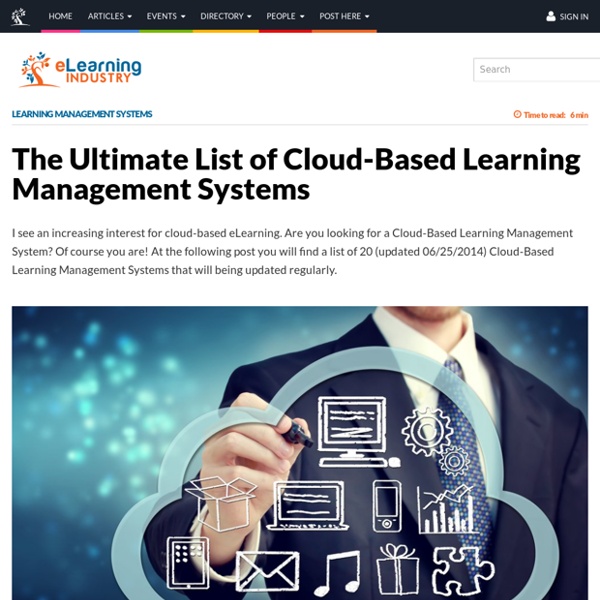



Custom Online University | Vitalect elearning SaaS Platform, Integrated with Webex, Citrixonline, Free Test drive The Top 8 Free/Open Source LMSs Update 10/26/16: Back by popular demand! We saw your comments and decided to incorporate the free LMSs you told us about. We’ve also upgraded our honorable mentions into full entries in order to give you better information about each one. I have a friend who once wrapped his entire body, head to toe, in tin foil. He also wrote “steak + guacamole” on himself in permanent marker, and then sauntered (in public, on public sidewalks with normal people all around) to his local burrito joint. People will do a lot just to get something for free. I’ve collected a list of the very best freemium, totally free, and/or open source LMSs out there, and it’s all below, no enduring of awkward stares on the sidewalk required. 1. This is the gorilla in the room of open source LMSs. Moodle’s welcome screen Differentiating features Pros/cons Review it here! 2. An example of creating a lesson plan in CourseSites Review it here! 3. Another open source solution, Sakai differs from Moodle in a few key elements. 4. 5.
Plateforme et ressources - ALIMENTERRE Skip to Main Content Area Accueil » banane Se connecter Nous suivre Rejoindre sur FacebookSuivre sur TwitterS'abonner au flux RSS Recherche avancée Langues Catégories Thématiques Zones géographiques Date de parution Rechercher Réinitialiser la recherche Vos critères de recherche : 106 éléments trouvés banane Photo Togo, récolte de bananes plantain Bananes Voir la ressource Togo, coupe bananes plantain Voir la ressource Togo, Bananiers Voir la ressource Fiche innovation/Guide Sélection participative et diffusion de variétés performantes de banane plantain Dans le cadre d’un projet porté par le Groupe d’appui, d’encadrement et de recherche en milieu rural (GERME) et le ... Bananes, Maraîchage, Agriculture familiale, Semences, Filière, Commercialisation, Nourrir les villes, PAFAO, Eau, Concertation Voir la ressource Témoignage Développer la filière banane plantain au Bénin en sélectionnant et diffusant les meilleures variétés. 70 % de la population active au Bénin vit de l’agriculture.... Voir la ressource Sensibiliser
Top Open Source Learning Management Systems Open source Learning Management Systems have become extremely popular in recent years, but what does open source mean? Open Source technology is technology where the source code is “open”, that is, the code is available to the public and free to be modified. Improvements can be made by developers and it can be spread or sold to the wider community. So, why should an organization choose an open source Learning Management System as opposed to a homegrown or proprietary LMS? With the huge number of Learning Management systems available today, making the decision on which platform to choose can be quite overwhelming. MoodleMoodle is an abbreviation for “Modular Object-Oriented Dynamic Learning Environment” although when it was first developed the M stood for Martin’s after its developer, Martin Dougiamas. Features: .LRN.LRN (dot learn) was originally developed at MIT and is used by almost 500,000 people in educational institutions, corporations and government in over 18 countries. Conclusion
150+ Course/Learning Management Systems & Learning Platforms Last updated: October 4, 2019 at 15:10 pm Platforms and systems used to host and manage online learning – LMS, CMS as well as Learning Experience Platforms Listed in alphabetical order. means is on the Top 200 Tools for Learning 2019. .LRN LRN is the world’s most widely adopted enterprise-class open source software for supporting e-learning and digital communities.Cost: Free. Open Source | Available: Download 360Learning 360Learning drives scalable business impact. Abara LMS Modern, mobile-first LMS, specially designed for corporates, training and elearning companies with best in class features. Absorb LMS Absorb LMS is a powerful and flexible Learning Management System. accessplanit accessplanit provides powerful all-in-one Training Management Software and Learning Management Systems to businesses that deliver training.Cost: Commercial | Available: Hosted Administrate Administrate is a training management solution delivered from the cloud.Cost: Commercial. Axonify Moodle Travitor
Toolkit: Tools for Delivering eLearning with HTML5 (Part 1) by Joe Ganci “Some vendors claim to deliver to HTML5 when in reality they deliver to HTML4, as they have all along. While HTML4 will also work on most mobile devices, tools that publish to HTML and not to Flash do not generally allow for learning experiences as rich as those that publish to Flash. No tool at this time takes advantage of most of the features that are unique to HTML5. The following are your best bets for creating eLearning that publishes to HTML5.” If you work in eLearning, and even if you don’t, you’ll likely have heard how everything is changing when it comes to delivering eLearning. HTML5 is not a total replacement for Flash nor is it without its own set of issues. This story has two parts. Delivering to the desktop Many organizations do not update their web browsers on a speedy basis, and therein lies an issue. This site will give you a score between 0 and 500, the higher, the better. Table 1 Browser Score from HTML5test.com Delivering to mobile devices Limitations Advantages